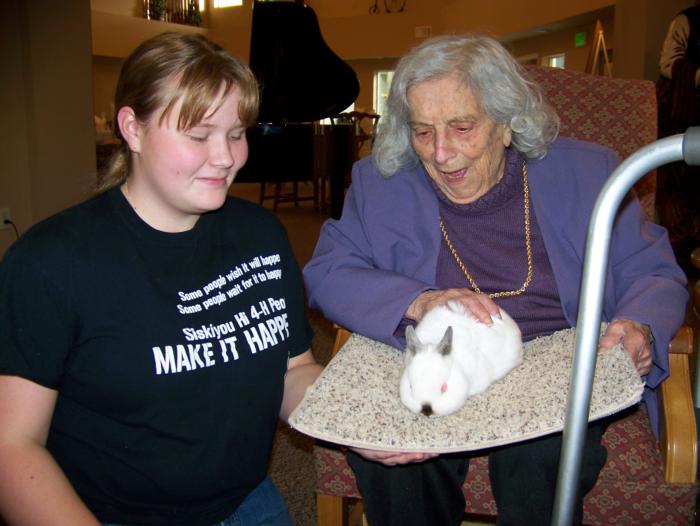4-H Delivers
Siskiyou Pet Pals

Senior citizens make up a large percentage of Siskiyou County’s population. Often, their extended families often no longer live near them. Making it more difficult, the inclement winter weather frequently prohibits the county’s older population from venturing outside. A rise of depression then occurs when these problems are combined with a lack of visits from family and friends. To help prevent the depression and the resulting negative health consequences, the Hi 4-H leadership project provides a connection and bright spot for Seniors through the Pet Pals program.
What has 4-H Done?:
Siskiyou County Hi 4-H project helps high-school aged youth by providing caring adults, a safe environment and opportunities to showcase their newly learned skills by creating and implementing annual service learning projects. For the 2010/2011 year these older youth in the Hi 4-H program created a program called Pet Pals. The original goal of the service learning project was to train therapy dogs to visit assisted living centers and provide much needed morale boosts during the long winter months. The program grew into much more than originally imagined.
The first step was to form a collaboration of life enrichment services between the 4-H members and Meadowlark assisted living center. From this partnership, the Hi 4-H members discovered they would be working with adults that had mobility issues, decreased vision, hearing impairments and that part of their time would be spent with the residents living in the memory care unit. Each group set a budget and applied for a grant from the California State 4-H Service Learning Fund to provide the necessary resources to continue with the project. To help learn about the assisted living center residents’ disabilities, the Hi 4-Hers participated in a workshop called A New Perspective which taught the youth to view the perspective a disabled person has through first-hand experiences. The youth then worked with another organization to learn what was needed for an animal to be considered for a therapy program including temperament and health requirements. Once the Hi 4-H youth had the necessary information, they began training and recruiting animals for the service project. This recruitment process involved rescuing/adopting one dog while recruiting dogs that belonged to high school students and other 4-Hers. After the dogs had been properly trained, the youth began visiting the facility once a week throughout January and February 2011 and are now currently visiting on a monthly basis. Residents were also provided a photo of the youth and pets participating in the project.
To share their new knowledge, the teens in the program have begun providing workshops to elementary school students which teaches the students how to begin their own service learning projects. By August 2011 these workshops had reached almost 300 youth.
The Payoff:
The teens involved in the program learned who they are, that they are capable of making a difference, and that they can influence change. Through the service learning project they learned how to plan, create and implement a successful program. Helping the assisted living center residents has inspired the Hi 4-Hers to plan more service learning projects and continue their philanthropic endeavors through individual volunteering, 4-H, school and other community programs. The assisted living center also saw a payoff in that the overall morale of each participating resident was improved. Additionally, the memory care center saw a significant improvement in one individual who went from being non- communicative and wheelchair bound to interacting and standing to greet the youth and therapy animals upon each visit.
The single most beneficial aspect was showing the residents that someone cares about them. On the first day, when the Hi 4-H members walked in, there was acknowledgement from the residents, but the residents didn’t begin to smile, gain energy and surround the 4-H members until when the dogs arrived. The residents’ mood changed instantly in the presence of the canine companions.
“I really knew we were making a difference [in the memory care ward] when the residents started remembering the animals’ names and were happy to know that we would be coming back.”
-Katelynn, Age 14
“We have had residents making connections and interacting, which in some cases has not happened in months”
-Solfrid, Meadowlark Life Enrichment Director



